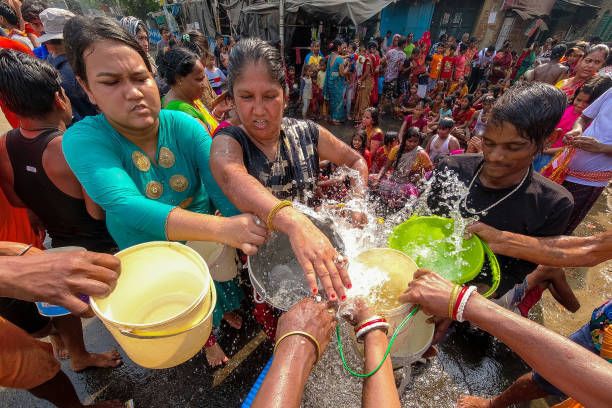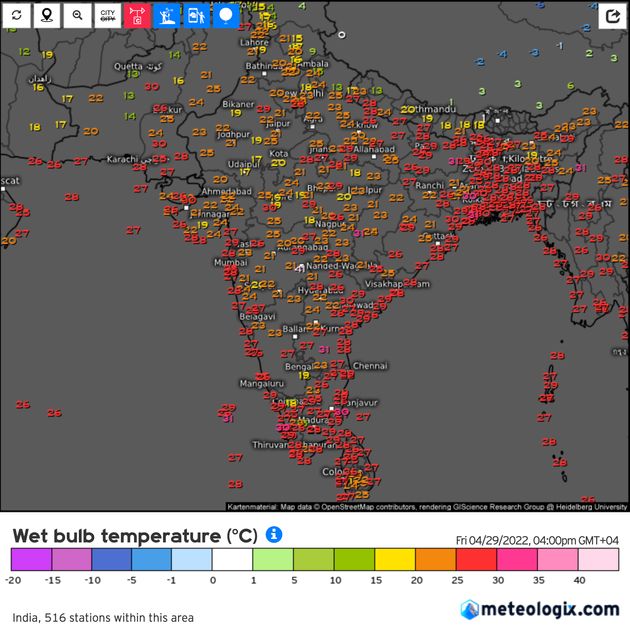NurPhoto via NurPhoto via Getty Images
HEAT WEATHER – “To die of heat” is no longer just an expression in India and Pakistan. The two South Asian countries have been experiencing unprecedented heat waves for two months. The temperatures there are hellish and reach a peak this Wednesday 11 at more than 50°C. The heat, combined with high levels of humidity, already exceeds the survival threshold for people who are outdoors for an extended period of time.
This threshold, scientists estimate it at 35 degrees “wet thermometer” (Tw) for people in good health. This value takes into account the humidity of the air to measure our resistance to heat. The more humid the air, the more the air is saturated with water, and the more the efficiency of our perspiration decreases. If the air humidity was 100%, our sweat would no longer cool us.
Clearly, the human body does not tolerate moist heat very well. If man can withstand 100°C tUntil the air is dry and the body can sweat, from 25°C in a humid zone, the air becomes unbreathable. This is also why you probably tolerate the temperatures of the sauna, which are higher, more easily than those of the hammam.
Screenshot
In six hours, the body succumbs
Experiments show that a wet bulb temperature well below 35 degrees Celsius is already fatal. A study of theAmerican Physiological Society released in January 2022, measured the ability of healthy young adults to perform simple tasks under six different extreme weather conditions. The experiment of a few hours revealed that no participant reached the limit of 35° Tw. A limit considered “high” by the authors, the heat tolerance would have been much lower in elderly or vulnerable people.
At less than 35°C, without being able to cool off, in about six hours, the body succumbs. Under certain climatic conditions, deliquescence is even faster. For example, in France, during the 2003 heat wave, the damp heat did not exceed 28° Tw. However, across Europe, with more than 70,000 dead, this heat wave is historically the deadliest.
In Asia, the death threshold has been largely exceeded in recent days. The wet bulb temperature is nearly 30° Tw, two degrees above what scientists consider tolerable for the human body. The city of Jacobabad, in Pakistan, has already recorded six days where the wet temperature has exceeded 35° Tw this year.
More and more deadly temperatures
This extreme heat is already claiming its first victims. In the Indian state of Maharashtra, 25 people have died since March due to heat. And mortality related to heat waves in India, already the victim of deadly heat waves in 2015 and 2019, has increased by more than 60% since 1980, according to the Indian Minister of Earth Sciences.
The future looks even bleaker. In a published study in May 2020 in the magazine ScienceAdvancesBritish and American researchers have found that the frequency of wet-bulb temperatures reaching 27°C, 29°C, 31°C and 33°C around the world doubled between 1979 and 2017. They predict that these deadly values will spread to vulnerable regions of the world as climate change increases.
Raymond et al., 2020, “The emergence of heat and humidity too severe for human tolerance”
The hotspots to watch closely are the southern Asia and the Middle East, add the authors of this scientific work. Subtropical and coastal countries, such as California or Mexico, will also have to deal with these heat waves more and more regularly.
“What we see now will be normal, even cold, in a world between +2° and +3°C,” explains Friederike Otto, from Imperial College London. A large part of the world’s population will have no choice but to desert these places in the most extreme conditions.
See also on The HuffPost: Extreme heat wave in India, a fire ravages a dump in Delhi and suffocates its inhabitants




